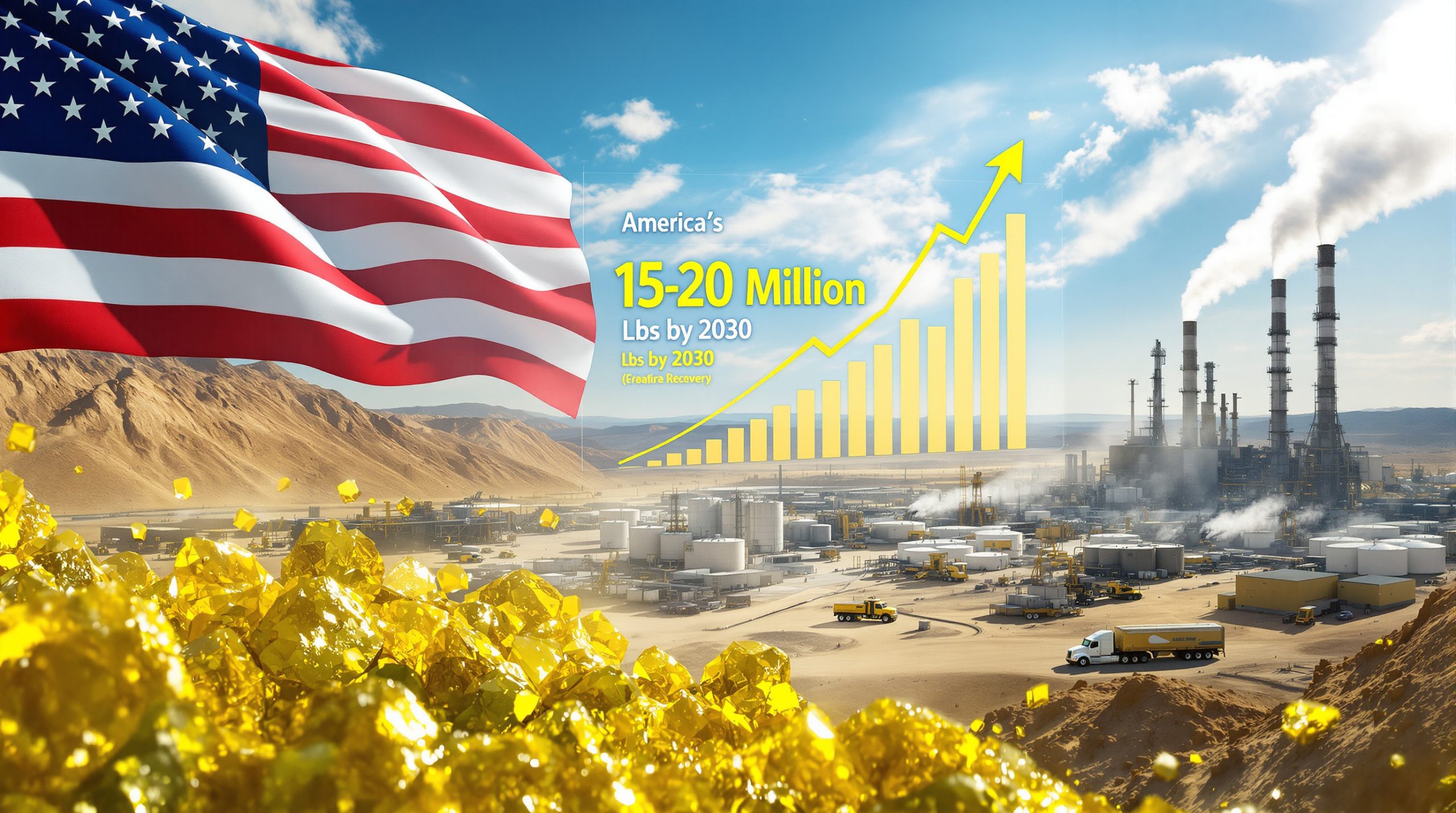Understanding Nuclear Fuel Manufacturing: The Critical Bridge Between Uranium Resources and Reactor Operations
Nuclear fuel fabrication represents the most specialised segment of the nuclear supply chain, transforming enriched uranium hexafluoride into precisely engineered assemblies tailored for specific reactor configurations. This manufacturing process involves converting uranium powder into ceramic pellets, loading these pellets into zirconium alloy tubes, and assembling these tubes into geometric arrays designed for particular reactor types. Unlike commoditised uranium or conversion services, fabricated assemblies are bespoke products requiring multi-year qualification programmes when utilities attempt supplier transitions. The growing fuel fabrication demand in nuclear sector reflects both expanding reactor fleets and technological advancement.
The Non-Fungible Nature of Reactor-Specific Components
Each reactor design demands unique fuel assembly specifications that cannot be substituted across different technologies. A Pressurised Water Reactor assembly featuring 17×17 rod arrays cannot replace fuel designed for Boiling Water Reactors with their 8×8 to 10×10 configurations, and neither can substitute for Russian VVER reactors utilising hexagonal assemblies. This technical specificity creates substantial barriers to supply chain flexibility, establishing multi-year timelines for alternative supplier qualification.
The engineering precision required extends beyond basic geometric configurations to include enrichment levels, burnup characteristics, and safety parameters specific to each reactor type. CANDU reactors utilise natural uranium bundles, while European pressurised water reactors require assemblies enriched to approximately 4.5% U-235. These technical requirements create distinct market segments with limited cross-compatibility.
Reactor Type Specifications:
• PWR Systems: 17×17 rod arrays dominating North American and European markets
• BWR Configurations: 8×8 to 10×10 arrays primarily in Japanese and Northern European facilities
• VVER Designs: Hexagonal assemblies serving Eastern European and Asian markets
• CANDU Technology: Natural uranium bundles in Canadian and Argentine reactors
Regional Demand Transformation Through 2040
Nuclear capacity expansion through 2040 concentrates heavily in Asian markets, with China leading construction activity followed by India, South Korea, and emerging nuclear nations. This geographic shift creates distinct patterns in the fuel fabrication demand in nuclear sector, fundamentally different from historical Western-dominated development. The concentration of new builds in Asia fundamentally alters the global fuel supply landscape, requiring fabrication capacity expansion in regions previously serving smaller reactor fleets.
First-Core Requirements Creating Demand Surges
New reactor commissioning generates first-core fuel requirements approximately three times larger than standard reload batches. With over 60 reactors under construction globally and another 100+ in planning stages, first-core demand creates periodic surges in fabrication requirements through the late 2020s and 2030s. The IAEA Reference Scenario projects nearly 3,000 tonnes of heavy metal per year for first cores by the end of the projection period.
Furthermore, recent developments such as the uranium mining halt in key producing regions highlight potential supply constraints that could intensify fabrication challenges. In addition, ongoing uranium market volatility continues to impact fuel supply chains globally.
Projected Regional Growth Patterns (2025-2040):
• Asia-Pacific Region: 150-300% increase in fuel demand depending on construction scenarios
• Middle East & Africa: 400-600% growth from historically low baseline levels
• Eastern Europe: 50-100% expansion through reactor life extensions
• North America: 25-50% growth through capacity uprates and new construction
The magnitude of Asian demand growth reflects not only the number of new reactors but also their larger average capacity compared to existing Western fleets. Modern Chinese and South Korean reactor designs typically operate at 1,000-1,400 MW capacity, requiring proportionally larger fuel inventories than older reactor generations.
Technology-Driven Market Segmentation
Advanced reactor technologies introduce specialised fuel requirements that differentiate market segments based on technical capabilities rather than geographic proximity. Small Modular Reactors require High-Assay Low-Enriched Uranium with enrichment levels between 5% and 19.75% U-235, representing fundamental departure from conventional reactor fuel enriched to approximately 3-5% U-235.
HALEU Market Development:
• TerraPower Natrium: 345 MW demonstration plant establishing HALEU fuel supply chains
• NuScale Power: SMR design utilising 4.95% enriched fuel in multi-reactor configurations
• X-energy Xe-100: High-temperature gas reactor using TRISO fuel particles
• Kairos Power KP-FHR: Fluoride salt-cooled reactor with specialised fuel requirements
Enhanced Accident Tolerant Fuels Reshaping Fabrication Economics
Enhanced Accident Tolerant Fuels incorporate new cladding materials and fuel compositions designed to withstand severe accident conditions while extending operating cycles. European Union regulations requiring ATF implementation from 2025 onward accelerate adoption timelines globally, creating demand for specialised manufacturing capabilities and higher enrichment feedstock.
E-ATF characteristics affecting fuel fabrication demand in nuclear sector include higher enrichment requirements for LEU+ applications up to 5% U-235, extended fuel cycles ranging from 18-month to 24-month operating periods, and increased uranium consumption of 10-15% higher natural uranium requirements per assembly. These technological advances command premium fabrication costs due to specialised manufacturing processes.
E-ATF development focuses on new cladding and fuel compositions offering significant safety and performance benefits while requiring adaptations to existing fabrication infrastructure.
The transition to enhanced fuels creates differentiated market segments where technical capability and regulatory licensing command premium pricing relative to commodity fuel fabrication. Companies with advanced technical capabilities and strong financial positions gain competitive advantages through this technological transition.
Geopolitical Supply Chain Reconfiguration
Russia's invasion of Ukraine triggered immediate reassessment of nuclear fuel supply dependencies across Central and Eastern Europe. Countries operating Soviet-designed VVER reactors initiated accelerated qualification programmes for Western fuel suppliers, fundamentally altering decades-old supply relationships and creating sustained demand for alternative fabrication capacity.
However, the implementation of a comprehensive ban on Russian uranium has accelerated these supply chain diversification efforts significantly. Consequently, US uranium production advancements are becoming increasingly critical for energy security.
European VVER Reactor Fuel Diversification
The non-fungibility barrier in fuel assemblies amplified disruption severity when utilities sought alternatives to Russian TVEL supplies. European utilities rapidly initiated multi-year qualification programmes for Western fabricators including Westinghouse and Framatome, creating structural inertia in supply chain realignment. Once alternative suppliers achieve licensing validation, utilities rarely revert given the substantial investment required for qualification.
VVER Fuel Transition Timeline:
• Phase 1 (2022-2024): Emergency licensing procedures and initial fuel deliveries
• Phase 2 (2024-2027): Comprehensive qualification testing and regulatory approval processes
• Phase 3 (2027-2030): Complete transition to non-Russian fuel supply chains
• Phase 4 (2030+): Long-term contract establishment with Western fabrication suppliers
United States Domestic Fuel Cycle Restoration
The Prohibiting Russian Uranium Imports Act and associated infrastructure investments represent systematic efforts to restore American nuclear fuel independence through both upstream uranium production and downstream fabrication capacity development. This includes enrichment capacity expansion through Centrus Energy's American Centrifuge program, HALEU production via DOE demonstration programmes, fabrication infrastructure modernisation for advanced fuels, and research and development programmes supporting fuel innovation.
The United States faces acute uranium supply challenges, with domestic consumption of approximately 50 million pounds annually while domestic production capacity reaches only 4-5 million pounds per year when fully ramped. This supply-demand imbalance drives strategic government support for domestic production capabilities.
Strategic Positioning for Market Growth
Companies combining low-cost uranium production with strategic geographic positioning stand to benefit most from tightening fuel fabrication demand in nuclear sector. Proximity to major fabrication facilities and alignment with friendly nation supply chain preferences create competitive advantages in an increasingly security-conscious market environment.
Tier-1 Jurisdiction Advantages
Uranium projects positioned in stable jurisdictions including Canada, Australia, the United States, and Namibia provide supply chain flexibility as utilities prioritise diversified sourcing strategies. This geographic positioning reduces single-country regulatory risks whilst maximising market access opportunities across Western nuclear markets.
Strategic Producer Characteristics:
• Jurisdictional Stability: Operations in allied nation frameworks prioritised by Western utilities
• Low-Cost Production: Sub-$30/lb all-in sustaining costs ensuring competitiveness across price cycles
• Development Timeline Alignment: Production ramp-up coinciding with demand acceleration
• Financial Strength: Balance sheet capacity supporting multi-year development programmes
Fabrication Service Provider Expansion
Traditional fuel fabrication companies invest in advanced fuel capabilities whilst expanding geographic footprints to serve growing Asian markets. These investments create both opportunities and competitive pressures within the sector as capacity additions must align with specialised fuel technology requirements.
Furthermore, industry innovation trends are driving technological advancement across the nuclear supply chain. Major fabrication companies including Westinghouse, Framatome, and Global Nuclear Fuel expand VVER fuel qualification, enhance ATF commercialisation capabilities, and develop BWR fuel technology advancement programmes. China National Nuclear Corporation scales domestic capacity for export market penetration.
Investment Implications of Fabrication Trends
Advanced fuel technologies requiring higher enrichment levels establish structural support for uranium prices by increasing natural uranium consumption per unit of electricity generated. This technological shift operates independently of reactor capacity additions, creating dual demand growth drivers supporting sustained price elevation.
Uranium Price Floor Elevation Mechanisms
Technology advancement creates multiple price impact pathways including enrichment intensity increases of 10-20% higher natural uranium requirements per assembly, fabrication premium pricing for advanced fuel technologies, supply chain security premiums reflecting geopolitical considerations, and long-term contract structures providing multi-year price visibility.
Price Impact Factors:
• Higher Enrichment Requirements: LEU+ and HALEU fuels increasing natural uranium consumption
• Premium Pricing Structures: Advanced technologies commanding higher fabrication margins
• Security Premium Valuations: Geopolitical considerations elevating contract values
• Long-Term Contract Frameworks: Multi-year agreements providing price stability
Manufacturing Capacity Constraints and Nuclear Deployment
While global fabrication capacity appears adequate for current reactor fleets, the transition to specialised fuels creates bottlenecks in advanced fuel manufacturing. HALEU production capacity represents a binding constraint on SMR deployment timelines, requiring substantial infrastructure investment to support next-generation reactor technologies.
Specialised Manufacturing Requirements
Advanced fuel technologies demand specialised production capabilities including HALEU enrichment facilities with limited global production capacity, TRISO fuel manufacturing for high-temperature reactors, advanced cladding material production and qualification systems, and quality assurance frameworks for regulatory compliance with new fuel designs.
Capacity Constraint Areas:
• HALEU Enrichment: Insufficient global production infrastructure for SMR deployment
• TRISO Manufacturing: Specialised fuel particle production for advanced reactors
• Advanced Materials: New alloy production requiring technical qualification
• Quality Systems: Regulatory compliance frameworks for innovative fuel designs
Infrastructure Investment Acceleration
Public and private investment in fuel cycle infrastructure accelerates driven by recognition that fabrication capacity constraints limit nuclear energy expansion. The DOE's HALEU Availability Programme, TerraPower's Natrium initiative, and industry collaborations illustrate active reindustrialisation in Western fuel supply chains.
Investment priorities focus on uprating existing facilities, adding production shifts to increase throughput, and developing specialised manufacturing capabilities. These approaches offer lower capital intensity compared to greenfield facility construction whilst addressing immediate capacity constraints.
What Drives Future Market Dynamics and Growth Sustainability?
Fuel fabrication demand in nuclear sector growth through 2040 will be supported by multiple reinforcing drivers including reactor capacity additions, technological advancement, and geopolitical supply chain reconfiguration. These interconnected growth factors create demand patterns less susceptible to individual market disruptions whilst establishing sustained visibility for uranium feedstock requirements.
Structural Demand Growth Drivers
Market expansion benefits from reactor construction momentum providing multi-decade project pipeline visibility, technology adoption cycles creating specialised demand through E-ATF and SMR deployment, supply chain localisation driving regional fabrication capacity development, and energy security priorities securing government support for domestic fuel cycles.
Demand Sustainability Factors:
• Construction Pipeline Visibility: Multi-decade reactor project development providing demand certainty
• Technology Adoption Cycles: E-ATF and SMR deployment creating specialised fuel requirements
• Regional Capacity Development: Localisation trends supporting fabrication infrastructure investment
• Government Support Frameworks: Energy security priorities driving policy support
Market Consolidation and Technical Capability
As fuel fabrication markets mature and technology requirements become more sophisticated, industry consolidation may accelerate. Companies with advanced technical capabilities and strong financial positions gain market share through acquisition activity and organic growth investments, creating concentrated supply chains with enhanced pricing power.
Additionally, developments in nuclear power economics continue to shape long-term investment decisions across the fuel cycle. The fuel fabrication segment represents a critical link between nuclear technology advancement and uranium market fundamentals, with fabrication demand increasingly driving uranium market pricing and supply chain development.
How Will These Trends Impact Long-Term Investment Strategies?
Understanding these dynamics provides essential context for evaluating investment opportunities across the nuclear fuel cycle, from upstream uranium production through downstream reactor operations. As global nuclear capacity expands and fuel technologies advance, fabrication requirements will increasingly influence uranium supply chain development through the next two decades.
The intersection of technological innovation, geopolitical security concerns, and capacity expansion creates sustained growth visibility supporting long-term investment positioning in uranium market participants positioned to serve evolving fuel fabrication demand in nuclear sector requirements.
Disclaimer: This analysis contains forward-looking statements and industry projections that involve inherent risks and uncertainties. Nuclear sector demand forecasts, technological adoption timelines, and geopolitical developments may differ materially from current expectations. Investors should conduct independent research and consider multiple scenarios when evaluating uranium market opportunities.
Looking to Capitalise on Nuclear Fuel Market Opportunities?
Discovery Alert's proprietary Discovery IQ model delivers real-time alerts on significant uranium and energy mineral discoveries across the ASX, empowering subscribers to identify actionable opportunities ahead of the broader market. With the nuclear sector experiencing unprecedented transformation and fuel fabrication demand accelerating globally, begin your 30-day free trial today to position yourself at the forefront of this evolving investment landscape.




